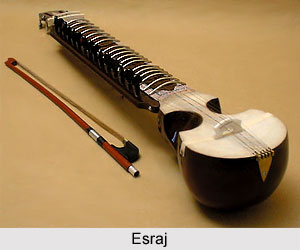 Esraj is a young instrument as it is only about 200 years old. It is found in the east and central areas especially West Bengal and Tripura. It is used in a somewhat wider variety of musical styles. Its name is translated as "robber of the heart." Esraj belongs to the category of bowed type of stringed instruments or vitata-vadya of Indian classical music
Esraj is a young instrument as it is only about 200 years old. It is found in the east and central areas especially West Bengal and Tripura. It is used in a somewhat wider variety of musical styles. Its name is translated as "robber of the heart." Esraj belongs to the category of bowed type of stringed instruments or vitata-vadya of Indian classical music
Structure of Esraj
Esraj has a medium sized sitar-like neck with 20 heavy metal frets. It neck holds on a long wooden rack of 12-15 sympathetic strings. Esraj has four main metal strings which are bowed. The soundboard is a stretched piece of goatskin. At times the instrument has a gourd affixed to the top for balance or for enhancement of tone.
The instrument can be rested between the knees while the player kneels with the neck leaning on the left shoulder. The technique is also a cross between the saringda and the sitar. It is bowed with a bow (known as gaz) in a manner like the sarangi. It is played with a bow with the other hand moving along the strings above the frets. The player may slide the note up or down in order to achieve the portamento, or meend.
Esraj is a combination of three instruments: sarangi, sitar and rabab. The base is like saringda or sarangi while the neck and strings are like sitar. It gives a sound like sarangi without being as difficult to play. The two main parts are called the kundi and the danda and it is played with a bow. The kundi is circular in shape and both the sides are equally punched and also covered with vellum. The danda which serves the purpose of the finger board is half round at the back and flat at the top side.The meend is also produced in a fashion very differently from the sitar.
Technique of Esraj
There seem to be two schools regarding the fingering of the esraj. One school shows a strong influence of the sitar. Here strong preference is given in using the index finger. One occasionally invokes the middle finger in order to gain speed. This approach is more common in North Eastern India.
The other school show more of an influence from the sarangi. Preference is given to the use of the middle finger coupled with the index finger. In this approach if one requires speed, one can use either the index or the ring finger to go in either direction. However such shortcuts are hardly employed.
In either case, the string is not locked against the fret as one would do with other fretted stringed instruments. One has to lightly touch the fret against the string. This allows one to alter the intonation easily. There is no problem raising or lowering the pitch at the fret. Frets of the esraj are mere guides for correct finger placement.
Usage of Esraj
Esraj is used as an accompanying instrument. It is an instrument of choice for singing Rabindra Sangeet singing. It has also been used as a solo instrument to interpret Hindustani Classical Music mainly in the Vishnupur tradition. The esrag is a modern invention from the Dilruba that was made and promoted by the Namdharis. The mode of playing the esraj consists of the alaap and gatkari systems. The biggest esraj is used for the presentation of the raga alaap as well as for orchestral purposes. Gatkari along with tan-toda and occasionally jhala too are played on the other two sizes of esraj. Other songs are also played on esraj in the anibaddha system.
Unfortunately, the popularity of the Esraj has been steadily declining. By the 1980s the instrument was almost extinct. With the rising influence of the "Gurmat Sangeet" movement, these instruments are once again in demand.
Famous players of Esraj
The most famous exponent of the esraj has been Pandit Ranadhir Ray, who died in 1988. Today, the best known exponent is Buddhadeb Das, also from Santiniketan. Deb kishore ghosh, a retired musicologist lecturer of Rabindra Bharati University and an advocate by profession, still plays the Esraj at the age of 70. birendranath Mukherji of howrah, Ashish Bandhopadhyay of Bishnupur and randhir roy of shantiniketan deserve mention. It is kanailal dheri of Gaya who is still regarded as one of the greatest Esraj player.




















